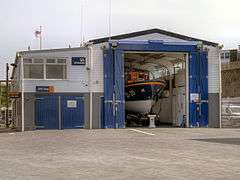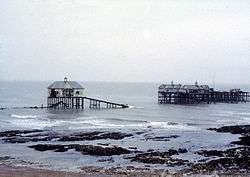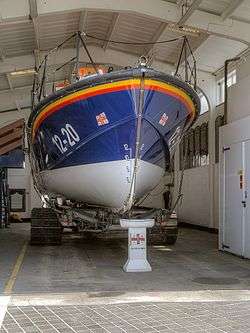Margate Lifeboat Station
Margate Lifeboat Station is an RNLI station located in Margate in the English county of Kent.[1] The station is over 150 years old and during that time, its crews have launched to many notable services including more than 10 awards for gallantry. Great sadness has also been experienced with the loss of ten members of its crews while saving others at sea.
| Margate Lifeboat Station | |
|---|---|
 | |
 Margate Lifeboat Station. | |
 | |
| General information | |
| Type | RNLI Lifeboat Station |
| Location | Margate Lifeboat Station, The Rendezvous, Margate, Kent, CT9 1HG |
| Country | England |
| Coordinates | 51°23′29″N 1°22′57″E |
| Opened | 1857 The first lifeboat Angela and Hannah was given to the town by Miss Burdett Coutts. |
| Owner | Royal National Lifeboat Institution |
| Technical details | |
| Material | Atcost concrete prefab frame with brick block and plastic cladding. |
History
The first lifeboat station in Margate was served by a lifeboat called Angela and Hannah which had been given to the town in 1857 by Miss Burdett Coutts.[2] The organization at that time was controlled by a committee of boatmen and town councillors. In the early months of 1860, the committee approached the RNLI and asked that they take over responsibility for the lifeboat and station. The RNLI agreed to the proposed takeover, but wished to carry out repairs and alterations to bring the " Angela & Hannah " up to the required RNLI standard. On 3 January 1861[3] the Margate committee instructed an architect to design a new boathouse which was to be located on land leased from the South Eastern and Chatham Railway company.[3] This proposal was rejected by the RNLI inspector who suggested that the existing lifeboat house located on the stone pier [3] be altered and improved to suit the requirements of the service. The work was carried out by a Mr Bushell for the sum of £75 and the boathouse was ready for use and opened on 31 August 1861.[3] The new lifeboat was called Quiver No.1 so named after The Quiver magazine,[4] a periodical of the time which had provided donations toward the cost of a new boat. The new lifeboat and launch carriage was delivered on 4 August 1866, and was launched from the new station on 7 August where a public demonstration took place.[3] In the preceding year it became apparent that the current launch system and location of the station on the stone pier had a few shortfalls. Among them was that on several occasions the horses used to launch the boat had refused to face the water thus causing delayed launches.
New Location
On 9 December 1896 during a visit to the station, the RNLI’s District Inspector, Engineer and Architect suggested that the lifeboat should be moved on to the town's iron jetty and be launched from slipways which should be constructed on either side of the jetty. An agreement between the Margate Pier and Harbour Company was reached and plans were agreed upon for two slipways operating two lifeboats. Following tenders the estimate of £3045 from Thomas Gibson of Westminster for the erection of the slipways. A storm occurred during the construction causing damage and revealing shortfalls in the design, and after inspection by the architect and engineers, it was apparent that revisions were required. The upper decks of the slipways were raised 18 inches more than the original specifications. With these problems and subsequent wrangling with the RNLI, the local committee and the harbour company delayed the completion for some time. The slipways designated Stations 1 and 2, were declared open by Rt. Hon. James Lowther the MP for Thanet on 14 May 1898. Early on the same day the two new lifeboats were handed over to the station and were christened Civil Service No.1 (ON 415)[5] on station No.2, and Eliza Harriet (ON 411) on station No.1.[3]
Developments and Improvements
Each slipway was provided with gas powered lamps in 1911. In 1923 the RNLI informed the station that they would be supplied with a new Watson-class motor lifeboat.[3] Construction of a new boathouse and slipway was completed by 21 March 1925.[3] The boathouse was 61 ft long and 22 feet wide [3] and was fitted with a petrol-driven winch and dynamo to provide lighting. The new lifeboat arrived on station directly from London where she had been on exhibition at the British Empire Exhibition at Wembley [6] and was called Lord Southborough (ON 688). Prior to her arrival at Margate, she was involved in a collision at Gravesend with a shrimping boat which ultimately sank.[3] This episode turned out to be the first service the new lifeboat performed when she rescued the two crewman.
No. 1 Station closed
In 1927 the No. 1 station was closed and the lifeboat Eliza Harriet was retired after 30 years service. In May 1928 the demolition of the western slipway commenced and was completed later that year.
World War II
The Second World War saw the station fall under the control of the Royal Navy. The day-to-day running of the station was still carried out by the Honorary Secretaries of the branch - Mr A C Robinson followed by Mr L C Arnold. Coxswain Edward Parker was awarded a Distinguished Service Medal for his work, taking the Lord Southborough[7] to the beaches during the Dunkirk evacuation.[8] Following the Dunkirk evacuation the Margate Station found itself very busy. From August 1940 the conflict known as the Battle of Britain raged in the skies above the south coast of England. One of the busiest lifeboat stations during the Battle of Britain was Margate along with the nearby Ramsgate station.
1950’s
The Lord Southborough was retired from the station in 1951, and in the 26 years that she was stationed at Margate, she had been launched 278 times saving the lives 869 people [3] in addition to the 600 troops she delivered to safety during the Dunkirk evacuations.[9] On 17 May 1951 the station took delivery of a new lifeboat called North Foreland (Civil Service No. 11) (ON 888)[10] and she was a 46 ft 9in Watson-class motor lifeboat. The boathouse sustained damage following a severe storm in 1953 requiring the complete replacement of the floor.
1960’s
On 20 May 1960 the Margate Station celebrated its centenary under the control of the RNLI. Records show that during the last one hundred years the station had saved more than 1800 people. The boathouse was once again the subject of considerable damage following a severe two-day storm which hit the North Kent coast on 16–17 October 1967. In 1966 the station also began to operate an inshore inflatable lifeboat D class with the designation D-99, and it was first called in to use to assist a yacht aground on Nayland Rocks on 19 January 1966.
1970’s
In late 1973 the AWL North Foreland returned from a massive overhaul and refit to bring her up to the standards of the day. These improvements included new radar equipment, echo sounder, radio equipment, air conditioning, improved internal lighting and a once-only self-righting capability. In 1974 the station was fitted with new winching equipment. The boathouse itself underwent some repairs, and repairs and maintenance carried out to the slipway and its pilings. In September 1974 the Margate Pier and Harbour Company closed the iron jetty to the public as it had become unsafe, but provision was made for the lifeboat and crew to carry on using the jetty for the lifeboat station. Negotiations between the Branch and the RNLI went on for the next few years about the precarious health and safety issues arising from the state of the iron jetty. In 1977 a decision was made that a new carriage-launched, Rother-class lifeboat would be sent to Margate and that a new station would be built on shore. In December 1977 the Branch informed the Margate Pier and Harbour Company that the RNLI was now in a position to move the station to the shore location and that contracts were about to be signed and building work would begin very soon.
The Great Storm of 1978

On 11 January 1978 [11] a violent storm with gale-force winds and waves hit the North Kent coast which brought the station's connection to the iron jetty to a fast conclusion. Most of the iron jetty was washed away during the storm leaving just the boathouse and slipway with no access to the severely damaged lifeboat house from the shore.[12] An RAF Helicopter airlifted an RNLI inspector to the boathouse the next day to assess the damage, and to see if it would be possible to launch the lifeboat stranded inside.[3] It was decided that a launch would be attempted and members of the crew were lowered down by the helicopter.[13] After some persuasion, the doors were forced open and the lifeboat was launched with great risk. This was the last launch of North Foreland, and she was taken into Margate Harbour where she remained until she was transferred to Ramsgate where she operated until the new lifeboat was ready to take over at Margate.[3] The inshore station had also sustained damage and that was temporarily housed at Margate Police Station.[3]
New Lifeboat Station

Work began on the present lifeboat station in March 1978 and was carried out by the Canterbury division of Wiltshire Construction Company Ltd with the work to be completed in 20 weeks. The new Rother-class lifeboat Silver Jubilee (ON 1046)[14] was handed over in November 1978 and she performed her first service from the new station on 27 October.[3] In the mid-1980s the Margate Station Committee split into two organizations; the Margate RNLI Fundraising Branch and the Margate Lifeboat Operational Committee, with the latter solely concerned with the day-to-day running of the lifeboat station. In 1991 the Silver Jubilee was replaced by the Mersey-class lifeboat Leonard Kent (ON 1177).[15] In 1996 the RNLI submitted plans for the boathouse to be enlarged and upgraded, and the work including improved crew facilities, was completed by September 1998.
Fleet
No. 1 Station Lifeboats
| Dates in service | Class | ON | Op. No. | Name |
|---|---|---|---|---|
| 1857–1866 | Self-Righter | Angela and Hannah | ||
| 1866–1883 | Self-Righter | Quiver No. 1 (1) | ||
| 1883–1898 | 37ft Self-Righter | ON 265 | Quiver No. 1 (2) | |
| 1898–1927 | 40ft Self-Righter | ON 411 | Eliza Harriet |
No. 2 Station Lifeboats
| Dates in service | Class | ON | Op. No. | Name |
|---|---|---|---|---|
| 1898–1925 | 40ft Self-Righter | ON 415 | Civil Service No. 1 | |
| 1925–1951 | 45ft Watson-class | ON 688 | Lord Southborough (Civil Service No. 1) | |
| 1951–1978 | 46ft 9in Watson-class | ON 888 | North Forland (Civil Service No.11) | |
| 1978–1991 | Rother-class | ON 1046 | 37-33 | Silver Jubilee (Civil Service No.38) |
| 1991–present | Mersey-class | ON 1177 | 12-20 | Leonard Kent |
Inshore lifeboats
| Dates in service | Class | Op No | Name |
|---|---|---|---|
| 1966–1975 | D-class (RFD PB16) | D-99 | Unnamed |
| 1975–1984 | D-class (RFD PB16) | D-182 | Unnamed |
| 1984–1989 | D-class (Zodiac III) | D-294 | Bill Mellis |
| 1989–1999 | D-class (EA16) | D-400 | Tigger |
| 1999–2008 | D-class (EA16) | D-545 | Tigger Too |
| 2008–present | D-class (IB1) | D-706 | Tigger Three |
Auxiliary vehicles
References
- OS Explorer Map 150 – Canterbury & the Isle of Thanet. Published: Ordnance Survey – Southampton. ISBN 978 0 319 2351 88.
- "Margate Cemetery - Est. 1856 - The Friends of Margate Cemetery". Thomas William Watler :- Grave number 1847, Section P – Reference to first lifeboat service. Produced by The Friends of Margate Cemetery. Archived from the original on 2 August 2013. Retrieved 4 September 2013.
- The Margate R.N.L.I. Station – And its Lifeboats from 1860. Author: Walters. AP. Publisher:Axxent Ltd.ISBN 0 9531620 0 1
- "The Quiver". The Victorian Web – Literature, history, & cultire in the age of Victoria. The Victorian Web. Retrieved 13 September 2013.
- Fawkes, Leslie G; Barker, Tony; Morris, Jeff. Peter Sims (ed.). 125 Years of CISPOTEL support for the Royal National Lifeboat Institution - A History of the Fund and its Lifeboats (PDF). Civil Service No.1. p. 18. Archived from the original (PDF) on 12 September 2014. Retrieved 13 September 2013.
- "Lifeboat House-Wembley". Description of the exhibition and the lifeboat display. © Exhibition Study Group 1993. Retrieved 13 September 2013.
- "The Association of Dunkirk Little Ships". Lord Southborough Lifeboat. Association of Dunkirk Little Ships. Retrieved 4 September 2013.
- Heroes All! – The story of the RNLI. Authur: Beilby, Alec. Publisher: Patrick Stephens Ltd – Haynes Publishing Group 1992. The Kent Stations- Reference to Dunkirk page 162. ISBN 1 85260 419 0
- Mayday Mayday – The History of Coastal Rescue in Britain and Ireland. Authors;Farrington, Karen – Constable, Nick. Publisher: Collins 2011. Work: Chapter. 3. page, 107 – Lord Southborough, Operation Dynamo. ISBN 978 0 00 744338 3
- Fawkes, Leslie G; Barker, Tony; Morris, Jeff. Peter Sims (ed.). 125 Years of CISPOTEL support for the Royal National Lifeboat Institution - A History of the Fund and its Lifeboats (PDF). North Foreland (Civil Service No. 11. p. 29. Archived from the original (PDF) on 12 September 2014. Retrieved 14 September 2013.
- Steers, J. A.; Stoddart, D. R.; Bayliss-Smith, T. P.; Spencer, T.; Durbidge, P. M. (July 1979). "The Storm Surge of 11 January 1978 on the East Coast of England". The Geographical Journal. 145 (2): 192–205. doi:10.2307/634386. JSTOR 634386.
- "Kent Coast Storm Damage". Photograph on Flicker of the storm damaged Iron Peir. Flickr photo sharing. Retrieved 3 September 2013.
- "The Storm of January 11, 1978". Photographs of the Storm Damage. Margate Local History website. Retrieved 16 September 2013.
- "Rother Class 37ft". List of Rother class lifeboats including Silver Jubilee. NavyNuts. Retrieved 16 September 2013.
- "Mersey Class Lifeboats". List of Mersey class lifeboats including Leonard Kent. NavyNuts. Retrieved 16 September 2013.